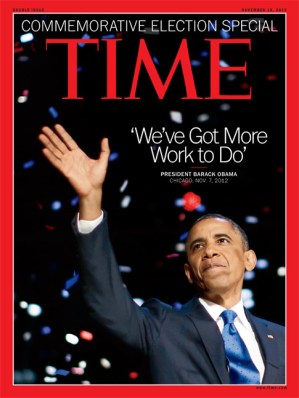Mitt Romney and Paul Ryan campaign in Findley, Ohio, nine days before the presidential election
The thing about an Etch A Sketch is that the picture never looks real. Mitt Romney‘s attempt to draw one self-portrait for the Republican primaries and a different one for the general election left voters unconvinced that he knew who he was. So how could they?
Republican primaries have become Tea Party litmus tests, forcing candidates to audition for a lily-white, antiurban base that feels like Archie Bunker and Ward Cleaver in an era of Modern Family and Dora the Explorer. Romney, who governed Massachusetts as a centrist, had to sprint right to prove his “severely conservative” bona fides against primary rivals like Rick Perry and Michele Bachmann, giving President Obama general-election ammunition on issues like immigration, taxes, energy and popular spending programs like FEMA. Meanwhile, for the second straight election cycle, the GOP missed a chance to seize control of the Senate when no-compromise Tea Partyers like Todd Akin in Missouri and Richard Mourdock in Indiana beat more electable candidates in their primaries.
(Election 2012: Photos from the Finish Line)
Now it’s recrimination time. After the historic GOP congressional wave in 2010, many Republicans were sure Obama was destined for defeat in 2012. An incumbent who had presided over four years of high unemployment — and whose overwhelming unpopularity was discussed as an immutable fact on Fox News and talk radio — seemed ripe for the picking. His re-election has some party leaders worried that the GOP is out of step with demographic and ideological trends, preaching to a shrinking choir. They do not want to be what Congressman turned TV host Joe Scarborough has despairingly called “the stupid party,” with retro in-the-bubble ideas about rape, contraception and “self-deportation” that alienate a modern multicultural electorate.

But for all the punditry about a coming Republican civil war, it’s not clear that the party really wants to change in any serious way — or that it could change if it wanted to. Even GOP elites, while concerned that winnable races are being sacrificed on the altar of extremism, suggest that the party is likely to stay the course that worked in 2010. Congressman Tom Cole of Oklahoma, a former Republican political consultant, has been a consistent voice for pragmatism over purity inside the party, but he doesn’t foresee any radical shifts after Tuesday’s split decision. “It’s sobering that we’re throwing away Senate seats. But I don’t see a great schism,” Cole says. “I see a very unified, very conservative party that’s very alarmed about the growth of government. Who would be the generals in our great civil war?”
Superglued to the Past
Just about all Republicans acknowledge their party’s demographic dilemma. The electorate keeps getting less white, less rural and less evangelical — in short, less traditionally Republican. Polls suggested that Obama was on track to receive more than 90% of the black vote and over two-thirds of the fast-growing Latino vote, while winning huge majorities among young voters, gays and single women. The homogeneity of the Republican conventioneers who nominated Romney in Tampa was striking, especially compared with the Democratic diversity on display the next week in Charlotte. It’s working for the GOP in the old Confederacy, but nobody thinks that’s sustainable nationwide in the long term.
(PHOTOS: The Campaign in 100 Objects)
Some Republicans believe that the party needs to cut a deal with Obama on immigration reform so Latinos will stop seeing the party as a hostile force. New Mexico has morphed from swing state into blue state; Arizona may soon drift from red state to swing state. But others blame at least some of the GOP’s problems with voters of color on the unusual phenomenon of a President of color. They believe the party is gradually broadening its appeal, citing rising Hispanic stars like Governor Susana Martinez of New Mexico, Senator Marco Rubio of Florida and newly elected Senator Ted Cruz of Texas. Patrick McHenry, a North Carolina GOP Congressman, argues that his party doesn’t need to change its policies to pander to minorities; it just needs to work harder to sell its policies to them. “Are we more diverse now? Yes. By leaps and bounds? No,” he says. “We’ve got to reach out to a broader array of Americans. But we’ve still got to stay true to who we are and what we believe.”
It’s the “what we believe” part that could cause Republicans more problems down the road. In the Obama era, the GOP has coalesced around an agenda that in some ways simply denies reality, rejecting the science of climate change, insisting that government (except the Pentagon) is incapable of creating jobs, denouncing debt while proposing debt-exploding tax cuts. Some of its fire breathers argued last year that shutting down the federal government and even defaulting on its obligations could be good for the economy; more recently, its leaders suppressed a Congressional Research Service report questioning supply-side dogma. Former Utah governor Jon Huntsman, an accomplished fiscal conservative feared as a formidable potential opponent by Team Obama, may have doomed his primary chances with one tweet: “I believe in evolution and trust scientists on global warming. Call me crazy.” Republican voters did, but then polls show most GOP regulars don’t even believe Obama is a Christian, many doubt he is a native-born citizen, and few changed their mind after he released his birth certificate. In April 2011, the birther Donald Trump actually topped the Republican presidential-primary polls.

